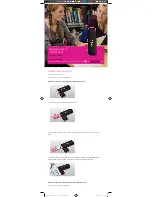
22
ASYNC/SYNC 2-WIRE SHORT-HAUL MODEMS
4.2 Power-Up, Normal Operation, and Power-Down
Making sure that you follow the guidelines in
Section 3.4
, power up the
Async/Sync 2-Wire Short Haul Modem by plugging its AC power cord to an
working AC outlet. (The unit has no power switch. To power it down, unplug it.)
The PWR LED should light, indicating that the unit is on.
If the local and remote A/S2W SHM units are both operating and transmitting
data, the units’ front-panel indicators should look like this:
PWR
Steadily lit
TD
Steadily lit or flickering depending on the data being transmitted.
RD
Steadily lit or flickering depending on the data being received.
RTS
Steadily lit or dark depending on the status of the RTS signal from the
local DTE.
DCD
If the local unit’s DCD jumper is set to DCD, steadily lit; if the local unit’s
DCD jumper is set to CNT, steadily lit or dark depending on the status
of the RTS signal from the remote unit.
LOS
Flashing until the units synchronize with each other, then dark.
ERR
Flashing until the units synchronize with each other, then dark.
TEST
Flashing until the units synchronize with each other, then dark.
If the LEDs don’t look like this, make sure that:
• One A/S2W SHM’s CLOCK jumper is set to internal (INT) or external (EXT)
clock, and the other unit’s CLOCK jumper is set to loopback (LBT) clock.
• Both units’ four front-panel pushbuttons are in the OFF position (not
depressed).
Once a A/S2W SHM begins operating normally, it will continue to do so
indefinitely without needing to be attended, except when occasional monitoring of
LED indicators is required. If you have difficulty, perform the diagnostic tests
described in
Section 5.1
. If you still can’t solve the problem, call Black Box as
described in
Section 5.2
.
Summary of Contents for ME375A-R2
Page 33: ...NOTES...














































